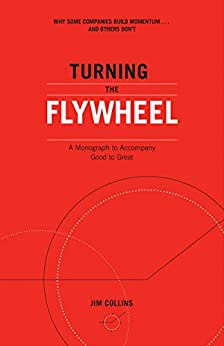More on this book
Community
Kindle Notes & Highlights
by
Jim Collins
Read between
December 30 - December 30, 2022
Lower prices led to more customer visits.
This greater efficiency then enabled it to lower prices further.
the greatest danger in business and life lies not in outright failure but in achieving success without understanding why you were successful in the first place.
When you deeply understand the underlying causal factors that give your flywheel its momentum, you can avoid Burgelman’s trap.
It was really more of a transfer of momentum from memories to microprocessors,
If you wake up one day to realize that your underlying flywheel no longer works, or that it’s going to be disrupted into oblivion, then accept the fact that it must be recreated or replaced.
But what truly set the big winners apart was their ability to turn initial success into a sustained flywheel, even if they started out behind the pioneers.
They figure out how to harness the flywheel effect within their unit of responsibility. No matter what your walk of life, no matter how big or small your enterprise, no matter whether it’s for-profit or nonprofit, no matter whether you’re CEO or a unit leader, the question stands, How does your flywheel turn?
“We don’t want to evoke an appreciative audience response,” Morris explained. “We want to provoke a passionate audience reaction.”
means that you simply cannot falter on any primary component and sustain momentum.
“Genius of the AND.” Instead of choosing between A OR B, they figure out a way to have both A AND B.
When it comes to the flywheel, you need to fully embrace the Genius of the AND, sustain the flywheel AND renew the flywheel.
You work shoulder to shoulder with your colleagues, throwing whatever skills you have into the mix to save as many lives as possible and get them home to the people they love.
highly collaborative culture filled with people utterly obsessed with caring for patients.
two possible explanations for a stalled or stuck flywheel. Possible explanation #1: The underlying flywheel is just fine, but you’re failing to innovate and execute brilliantly on every single component; the flywheel needs to be reinvigorated. Possible explanation #2: The underlying flywheel no longer fits reality and must be changed in some significant way. It’s imperative that you make the right diagnosis.
More often, momentum stalls due to either poor execution and/or failure to renew and extend within a fundamentally sound flywheel architecture.
The big successes tended to make big bets after they’d empirically validated that the bet would pay off, whereas the less successful comparisons tended to make big bets before having empirical validation.
a conceptual shift from “running a business” to turning a flywheel.
firing bullets, then cannonballs. They crank the flywheel in their first arena of success, while simultaneously firing bullets to discover new things that might work, and as a hedge against uncertainty.
Every large organization will eventually have multiple sub-flywheels spinning about, each with its own nuance. But to achieve greatest momentum, they should be held together by an underlying logic. And each sub-flywheel should clearly fit within and contribute to the whole.
demise of once-great companies happens in five stages: (1) Hubris Born of Success, (2) Undisciplined Pursuit of More, (3) Denial of Risk and Peril, (4) Grasping for Salvation, and (5) Capitulation to Irrelevance or Death.
Exit definitively or renew obsessively, but never—ever—neglect your flywheel. Apply your creativity and discipline to each and every turn with as much intensity as when you cranked out your first turns on the flywheel, nonstop, relentlessly, ever building momentum.
True discipline requires the independence of mind to reject pressures to conform in ways incompatible with values, performance standards, and long-term aspirations. The only legitimate form of discipline is self-discipline, having the inner will to do whatever it takes to create a great outcome, no matter how difficult.
When you have disciplined people, you don’t need hierarchy. When you have disciplined thought, you don’t need bureaucracy. When you have disciplined action, you don’t need excessive controls. When you combine a culture of discipline with an ethic of entrepreneurship, you create a powerful mixture that correlates with great performance.
you need disciplined people who engage in disciplined thought and take disciplined action to produce superior results and make a distinctive impact in the world.
Retain absolute faith that you can and will prevail in the end, regardless of the difficulties, and at the same time, exercise the discipline to confront the most brutal facts of your current reality, whatever they might be.
(1) what you’re deeply passionate about, (2) what you can be the best in the world at, and (3) what drives your economic or resource engine.
the discipline of what to do, but equally, what not to do and what to stop doing.
Shaping a culture that can thrive far beyond any single leader is clock building.
Building an organization that can generate many great ideas is clock building.
For true clock builders, success comes when the organization proves its greatness not just during one leader’s tenure but also when the next generation of lea...
This highlight has been truncated due to consecutive passage length restrictions.
what is a great organization—what are the criteria of greatness? There are three tests: superior results, distinctive impact, and lasting endurance.
In business, performance is defined by financial results—return on invested capital—and achievement of corporate purpose.
performance is defined by results and efficiency in delivering on the social mission.
if you’re a sports team, you must win championships; if you don’t find a way to win at your chosen game, you c...
This highlight has been truncated due to consecutive passage length restrictions.
If your organization went away, who would miss it, and why?
great enterprise transcends dependence on any single extraordinary leader; if your organization cannot be great without you, then it is not yet a truly great organization. Finally, I caution


